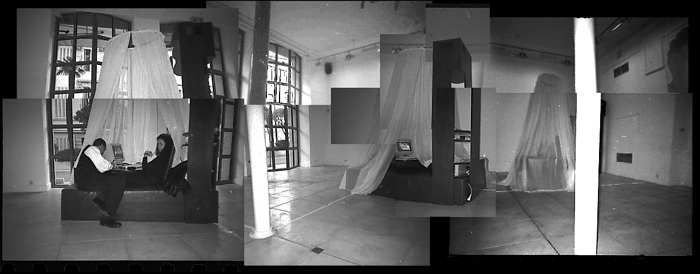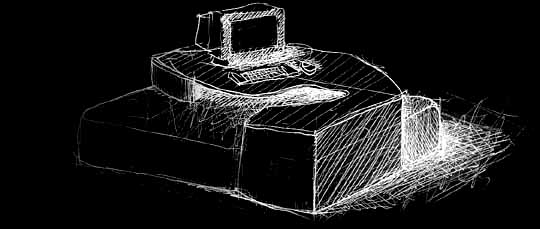Feb. 1999. First price at the Hakinara Design Exhibition in Osaka.
Dec. 1998. 6 Geek Nefs at Sony USA headquarters.
Sep. 1998. Selected for Global Tekno IV in Paris.
May 1997 - May 1998. CyberTheatre in Brussels.

Three Geek Nefs at FLEX97 (Pierre Nouvion Gallery in Monaco, February/March 1997)
Intro
Description
Why the Geek Nef
Assembly instructions
Intro.
On overloading a multitasking mind.
Web surfing is an intimate experience. The screen is a medium which fascinates us easily but details in our surroundings often bring us back to physical reality. A separation from the physical world will help the user focus on the information displayed on the screen therefore enhance the surfing experience. This separation needs not be radical. Attenuating the flow of information that we receive continually from the physical world such as variations in the levels of sound and light is enough to put this information in the background and to ease our focus on the virtual experience.
On recycling boxes.
It is now common knowledge that one of the keywords in the future of computing is ubiquity. Computers will be everywhere. They will be so small that we will not see them and so smart that we will not feel them. The move from desktops to laptops to palmtops computers identifies this change. Soon (or maybe not so soon) we won't need to perform physical actions such as moving the mouse and typing on the keyboard to experience virtual worlds but for some of us who are still using the boxy kind of computers to surf the Web here is a way to place physical reality in the background.
Here is the Geek Nef.
Description.
The Geek Nef is a sensual and cosy environment that adds comfort to the human/computer interaction especially when browsing the Web. The Geek Nef device is a morph between a desk and a bed.
Each Geek Nef is composed of:
- 1 resting piece or bed;
- 1 wooden desk that kind of snaps onto the bed;
- 1 padded wooden back rest attached to the desk;
- 1 optional wooden column also attached to the desk;
- 1 curtain/mosquito-net with its frame hanging from the ceiling.
The resting piece or bed is made of foams of different densities glued on top of a wooden sheet. The tight removable synthetic cover is attached to the wooden sheet with velcro. (Length = 200cm, width = 160cm, height = 40cm)
The wooden desk is the heaviest part of the Nef. It is placed on top of the bed. The bed should be at its definitive position before the desk is added to it. Moving the bed with the desk on top of it might be difficult and might rip the velcro off the synthetic bed cover.
The padded wooden back is covered on the user's side by the same synthetic material that is used to cover the bed. It is narrow so it doesn't block shoulder movements and high so the user can rest her head. This provides maximum comfort.
Two kinds of columns are available.
The full column (presented above) is designed to hold a video projector. It is made of two vertical panels and five shelves of which only one is adjustable. It is on this adjustable shelf that the projector is supposed to rest. The entire column is 250cm high.
The half column is made of two vertical panels and two fixed shelves. It is 110 cm. high. Use this column or no column at all if you don't want to incorporate a video projector to the Nef. Of course you may also connect the output of the Nef's computer to other video output devices (i.e. another screen or a projector attached to the ceiling).
The mosquito net is a separation from the physical world. It provides intimacy to the Nef. Even if the user chooses to accept one or two companions on board the mosquito net can be kept closed around the Nef. This creates a physical and psychological separation between the inside and the outside of the Nef which increases the comfort of the experience and the sensation of immersion.

The Geek Nef without its column.
Why the Geek Nef.
Lately we have been so busy imagining and creating new--virtual--worlds that the way we interact with computers, the state of our body when we use computers, has received only little attention.
The different elements of today's computer set-up--the box protecting the CPU, the output devices such as the screen and the printer and the input devices like the keyboard and the mouse--are designed to rest on flat and hard surfaces (FHSs).
Why do we have FHSs in the first place? Mainly to write but also to place items so they don't fall from those the supportive structure. For instance without an FHS one cannot place safely a vertical item such as a glass bottle. The bottomline is that we need such surfaces to leave objects onto them.
Having an FHS as a workplace is a very well established human habit--that can even be consider as not culturally bound--therefore it is not surprising that the first "desktop" computers were designed to fit in the existing workplace. Now that some of us are moving from physical to virtual living and knowing that objects are not part of these emerging virtual scapes why would we want our computers--our doors of virtual perception--to rest on those less and less necessary FHSs? A radical referencial change is needed.
The keyword of future computing is ubiquity. This is why laptop computers are now very common and palmtops are becoming mainstream. In a few years it is clear that computers are going to disappear. Read in "disappear" that computers are going to become so small that we will not see them and so intelligent that we will not feel them anymore. If you are still sceptical about these changes think of how the word "cyber" has recently shifted from the science fiction realm to the everyday vocabulary. Computers are definitely becoming part of us but this process may take longer than we expect.
Meanwhile for some of us who still use the rigid rest-on-flat-and-hard-surface type here is the Geek Nef.
The Geek Nef is an environment created to make the browsing experience more comfortable (Comfort, recycling the computers that we are using, privacy like when voting, cocoon).
Because the online experience/activity requires the players either to disclose an identity (real or fictitious) or to make a statement or both it is important in the case of public space to provide the player with privacy. The role of the (mosquito) net is mainly a psychological, yet also physical, protection from the outside. It provides the user with the needed privacy.
In 1997 and 1998 you could have experienced the Geek Nefs at the CyberTheatre in Brussels.
Intro
Description
Why the Geek Nef
Assembly instructions

